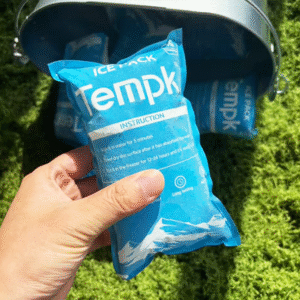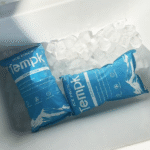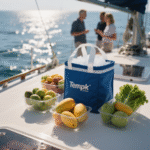How to Package Dry Ice Pack for Shipping in 2025?
Introducción: Packing dry ice packs correctly is essential for maintaining frozen or ultra cold conditions during transit. En el primero 50 words, note that this article explains how to package dry ice packs to protect perishables like vaccines and seafood. hielo seco sublimates at –78.5 °C, so your packaging must vent carbon dioxide gas to avoid pressure build up. This guide uses clear language and real world examples to help you ship confidently.
Why proper dry ice packaging matters – covering factors such as vented containers and pre freezing to protect goods.
How to calculate and layer dry ice – including weight estimates and “sandwich” placement to improve cold retention.
Regulatory and labeling requirements – from UN 1845 markings to class 9 Etiquetas de riesgo.
Modern packaging options – comparing VIP panels, EPS foam and phase change materials for cost, performance and sustainability.
2025 trends and innovations – highlighting smart sensors, blockchain traceability and reusable dry ice systems.
Why Is Correct Dry Ice Packaging Important?
Proper packaging ensures that frozen shipments arrive at the correct temperature and that safety risks are minimized. Dry ice is solid carbon dioxide and sublimates directly to gas, so an airtight container can burst from pressure build up. A vented design and insulation keep the payload cold while allowing gas to escape. Effective packaging also reduces wasted product and replacement shipments, saving time and money.
Beyond protecting products, correct packaging is required by regulators. Los EE. UU.. Departamento de Transporte (PUNTO) and International Air Transport Association (IATA) treat dry ice (Y 1845) as a hazardous material, mandating labels and maximum quantities per package. Failures to comply can delay shipments or result in penalties. Quality packaging therefore has both compliance and operational benefits.
Packaging Protects Quality and Reduces Waste
Cuando el hielo seco se sublima, it absorbs heat from the surroundings and maintains low temperatures. A robust package acts like a thermos, reducing heat transfer from the environment. Studies show that foam containers with a vacuum insulated panel (personaje) insert can retain temperatures up to 96–240 hours, reducing dry ice mass by 20–40%. This not only preserves product quality but also lowers shipping weight and cost. En contraste, poorly insulated or airtight packaging leads to rapid sublimation, causing temperature spikes and potential spoilage.
| Key Benefit | Evidence | Lo que significa para ti |
| Reduced spoilage | Proper layering (“base blocks + lados + top pellets”) reduces warm pockets, cutting delivery failures by 38% in a pastry company case study. | Fewer refunds and happier customers. |
| Lower costs | VIP panels allow longer hold times with less dry ice, reducing shipping weight and volumetric charges. | Savings on shipping fees and dry ice consumption. |
| Cumplimiento regulatorio | Labels showing “Dry Ice/Carbon dioxide, sólido,” UN 1845 and net weight are mandatory for air shipments. | Avoids fines and ensures smooth acceptance at carrier counters. |
Packaging Influences Safety
Dry ice is extremely cold (–109.3 °F), so touching it without protection causes instant frostbite. Wear insulated gloves and goggles when handling dry ice, and use tongs to avoid prolonged contact. Proper packaging must prevent direct contact between dry ice and food; use a barrier or separate compartment so consumers are not exposed to residual dry ice. Además, leaving vents open prevents carbon dioxide build up, reducing explosion and suffocation risks.
How Do You Choose the Right Packaging for Dry Ice?
Selecting the right packaging involves evaluating the product’s temperature requirements, shipment duration and regulatory context. Let’s explore the major factors.
Consider Temperature Sensitivity and Shipping Duration
Products such as vaccines often require ultra low temperatures (–20 °C to –70 °C). In these cases, dry ice provides reliable cooling because it maintains temperatures below freezing for 24–72 hours. Una guía general es 5–10 pounds of dry ice per 24 hours for every 10–15 pounds of product. Longer transit times or larger payloads require more dry ice and thicker insulation. The table below summarizes typical needs.
| Tipo de envío | Dry Ice Amount (lbs per 24 h) | Duración (horas) | Rango de temperatura | Significado práctico |
| Productos farmacéuticos | 5–10 | 24–72 | –20 °C to –70 °C | Ultra cold drugs like vaccines need heavy dry ice. |
| Mariscos | 1–2 | 24 | –18 °C to –20 °C | Lighter loads suffice; avoid over freezing. |
| Biotech samples | 5 | 48 | –20 °C to –50 °C | Enough to keep sensitive kits stable. |
| Alimentos congelados | 2–3 | 24 | –10 °C to –18 °C | Requires moderate dry ice for typical grocery shipments. |
If your product must remain refrigerated (2 °C–8 °C), material de cambio de fase (PCM) packs or gel packs may be safer because dry ice risks freezing the contents. For shipments requiring both refrigeration and freezing within the same package, hybrid solutions with PCM and dry ice can maintain multiple temperature zones.
Match Insulation to Transit Time
Insulation slows the rate at which dry ice sublimates and heat enters the package. Foam coolers made of expanded polystyrene (EPS) are common for 24–48 hour shipments. Upgrading to thicker EPS or polyurethane (Puro) adds another 24 horas de retención de frío. Vacuum insulated panels (personaje) entregar 96–240 hours of protection with thinner walls, making them ideal for international flights or high value cargo.
To decide which option suits you, consider the trade offs:
EPS/PUR (1–1.5 en) – Lowest cost but suitable only for shorter durations; add extra dry ice during hot weather.
Thick EPS/PUR (1.5–2 en) – Extended hold time; fewer hot spots and less dry ice required.
personaje (0.4–0.8 en) – Highest insulation efficiency with minimal thickness; reduces weight and shipping costs despite higher upfront cost.
Account for Regulatory Requirements
Air cargo carriers limit dry ice shipments to 200 kg por paquete and require UN 1845 hazard labels. Federal regulations (49 CFR 173.217) and IATA Packing Instruction 954 require packages to be vented to allow carbon dioxide gas to escape. En la práctica, carriers harmonize ground and air standards to simplify acceptance; you must mark the proper name “Dry Ice” or “Carbon dioxide, sólido,” specify the net dry ice mass en el cartón, and attach a Clase 9 etiqueta de peligro if shipping by air. Many carriers also follow the FedEx job aid specifying minimum font sizes and that hazard labels must be at least 100× 100 mm.
Failure to label packages correctly can result in delays or rejection at the carrier counter. Use the table below to ensure compliance.
| Required Mark | Descripción | Why It’s Required |
| Y 1845 Proper Name | "Hielo seco" o "dióxido de carbono, sólido" | Identifies hazardous material. |
| Peso neto | Kilograms of dry ice | Ensures carriers know the amount and it doesn’t exceed limits. |
| Clase 9 Etiqueta | 100×100 mm diamond label | Indicates miscellaneous hazardous material for air transport. |
| Shipper/Consignee Addresses | Names and addresses of sender and recipient | Enables tracking and traceability. |
Step by Step Guide: Packing Dry Ice for Shipping
This section provides a clear process that you can follow to package dry ice packs effectively. The goal is to maximize cold retention, ensure safety, and comply with regulations.
1. Pre freeze and Prepare the Product
Before packaging, pre freeze your product to at least 0 °F (–18 °C) so the dry ice can maintain, rather than create, the frozen state. Check that your product can withstand ultra cold temperatures; if not, use PCM packs instead.
2. Select a Rigid Outer Container and Insulated Liner
Choose a heavy duty corrugated box that can withstand shipping stresses. Insert an EPS, PUR or VIP liner based on transit duration. For shipments longer than 72 hours or international flights, Paneles VIP are recommended because they deliver high performance at lower weight. Ensure there are holes or venting channels in the liner and outer box to allow CO₂ gas to escape.
3. Calculate the Quantity of Dry Ice
Plan to use 5–10 lbs of dry ice for every 24 horas, adjusting for the product weight (10–15 lbs) and insulation quality. Add a 24 hour buffer to account for delays. Converting pounds to kilograms (1 lb ≈ 0.4536 kilos) ensures accurate labels.
4. Layer the Dry Ice Around the Product
Place dry ice blocks or pellets at the base of the liner, then add your pre frozen product in a sealed bag or container. Surround the sides and top with additional dry ice pellets to create a “sandwich” effect. This strategy eliminates warm pockets and ensures cold air circulates from the bottom up. Avoid having dry ice touch the product directly by using a barrier, especially for food shipments.
5. Vent and Close the Container
Seal the inner liner but do not make it airtight. Tape the outer corrugated box lightly at the seams, leaving small gaps or specialized vent holes so CO₂ gas can escape. Never use sealed plastic bags or steel drums for dry ice. If you’re shipping via air, confirm that your packaging meets IATA PI 954 venting requirements and that the total dry ice weight is under 200 kilos.
6. Label and Document
Affix hazard labels on the external container. Write the proper shipping name ("Hielo seco" o "dióxido de carbono, Sólido"), Y 1845, and the net weight of dry ice in kilograms. Para envíos aéreos, attach a Class 9 hazard diamond and include the statement “UN 1845, Hielo seco, n × kg” on the air waybill. Do not place labels inside document pouches or sleeves; attach them directly to the carton surface.
7. Train and Monitor
Train your staff on safe handling techniques: wear gloves and goggles, use tongs, and never handle dry ice with bare hands. Always include a temperature data logger or IoT sensor in the package. Real time monitoring helps you address issues in transit and provides proof of compliance.
Safety Measures and Regulatory Compliance
Handling dry ice involves both personal safety and adherence to hazardous material regulations.
Personal Protective Equipment and Handling
Due to extreme cold, direct skin contact with dry ice can cause burns or frostbite. Siempre usa insulated gloves and safety goggles. Use tongs or scoops when transferring dry ice. Store dry ice in a well ventilated area; never in sinks or closed containers where CO₂ can accumulate. Educate customers about safe handling and design your packaging to ensure residual dry ice has sublimated by delivery.
Venting and CO₂ Gas Management
The main hazard of dry ice is carbon dioxide gas buildup. Always provide venting channels in the packaging. Avoid sealed plastic bags, glass bottles, or steel drums because they cannot release gas and may explode. En cambio, use fiberboard, plástico, or wooden boxes with foam inserts, which let gas escape.
Ensure packages are not placed in passenger cabins or poorly ventilated areas. Para envíos aéreos, carriers limit the amount of dry ice and require packages to be loaded in cargo holds with dedicated ventilation. Keep packages upright, and avoid stacking heavy loads that might block vents.
Etiquetado y Documentación
Regulators require clear labeling to inform handlers. The package must display:
Nombre de envío adecuado – “Dry Ice” or “Carbon Dioxide, Solid.”
Número de la ONU - 1845.
Peso neto de hielo seco – expressed in kilograms.
Clase 9 etiqueta de peligro – diamond shape, mínimo 100 mm each side.
Para envíos aéreos, include the statement “UN 1845, Hielo seco, n × kg” on the air waybill. If the contents also include other dangerous goods, a Shipper’s Declaration may be required. Ground shipments in the U.S. generally do not need the Class 9 label but still require the proper name and net weight.
Regulatory Differences Between Carriers
Different carriers follow the same core regulations but may have additional requirements. Fedex y Unión Postal Universal both adhere to IATA PI 954. They instruct that packages be vented and not sealed, and they specify that the hazard label should not be placed inside sleeves. UPS recommends pairing dry ice with other refrigerants like gel packs when shipments extend beyond one to two days. They also emphasize using foam insulation and separating the product from dry ice to prevent direct contact.
Compliance for High Value or International Shipments
For shipments of high value biologics or international deliveries, carriers may require more stringent documentation. Many integrators harmonize ground handling procedures to match the more rigorous air standards; this means your package may still need a Class 9 label even on ground shipments. Always consult the carrier’s latest job aids and verify that your label sizes and fonts meet their minimum requirements. Keep training records and standard operating procedures (Sops) to satisfy audits and the Food Safety Modernization Act (FSMA) Sanitary Transportation rules.
Comparing Modern Packaging Technologies: Dry Ice vs PCM vs Hybrid Solutions
As cold chain logistics evolve, companies have more options than traditional foam coolers. New materials and hybrid systems promise improved performance and sustainability.
Phase Change Material (PCM) Paquetes
Phase change materials absorb or release heat at specific temperatures. PCMs can be engineered to maintain 2 °C a 8 °C or –20 °C and are commonly available as reusable gel or wax packs. Ellos son non hazardous, so shipments avoid many dry ice restrictions. PCM packs are durable and can be reused multiple times, reducing waste and long term costs. Sin embargo, they require preconditioning (freezing or heating) and validation to ensure performance. PCMs are best for refrigerated shipments or moderate frozen conditions (–20 °C). They are less suited for ultra cold needs (< –70 °C).
Empaquetado de hielo seco
Dry ice is cost effective for short term deep freeze shipments. It sublimates at –78.5 °C, providing ultra cold conditions. Its low cost makes it attractive, but it is single use and generates CO₂ emissions. Shipping with dry ice also requires hazardous materials training, labeling and venting. For shipments requiring less than 72 hours of deep freeze, dry ice remains the preferred choice. Para duraciones más largas, you may need larger amounts of dry ice or a hybrid system.
Hybrid Solutions and Smart Packaging
Hybrid systems combine PCM and dry ice to create multiple temperature zones within one container. Por ejemplo, dry ice can maintain –70 °C for the primary payload while PCM panels keep an adjacent compartment between 2 °C y 8 °C. Embalaje inteligente using IoT sensors monitors temperature, humedad, and location in real time, alerting users when conditions deviate from setpoints. Blockchain technology offers secure, immutable records of shipments, increasing traceability and accountability.
Sustainability and Cost Considerations
Environmental impact is a growing concern. Dry ice production repurposes CO₂ from industrial processes and does not add new carbon dioxide to the atmosphere, but the one time use generates waste. Reusable dry ice systems and advanced insulation can reduce dry ice consumption by 50% and cut waste up to 90%. PCM solutions require higher upfront costs but lower long term expenses due to reuse and reduced regulatory burdens. Al final, the best solution depends on your temperature range, duración del envío, presupuesto, y objetivos de sostenibilidad.
2025 Trends and Innovations in Dry Ice Packaging
Smart Sensors and IoT Integration
En 2025, sensores inteligentes and IoT devices are becoming standard in cold chain packaging. These sensors provide real time data on temperature, humedad y ubicación, enabling proactive intervention if a shipment deviates from the required range. Shipping companies use mobile apps and dashboards to view this information, reducing spoilage and improving accountability. Expect more integration with digital platforms and predictive analytics.
Blockchain for Traceability and Compliance
Blockchain technology is being incorporated into cold chain logistics to create secure, unalterable records of temperature data and custody changes. This technology streamlines audits, improves supply chain transparency and ensures that data cannot be tampered with. In regulated industries like pharmaceuticals, blockchain helps prove compliance with Good Distribution Practices (PIB) and ensures the authenticity of products.
Advanced Insulation and VIP Adoption
Vacuum insulated panels are gaining traction because they offer high thermal resistance with less bulk. En 2025, VIP adoption accelerated, enabling shippers to achieve 96–240 hours of cold retention with less dry ice. This reduces shipping weight, which lowers fuel consumption and carbon emissions. Además, new eco friendly insulation materials (p.ej., recycled fiber composites) estan surgiendo, further improving sustainability.
Reusable Dry Ice Programs
Reusable dry ice packaging systems, like Marken’s InfiniDI, combine advanced insulation and return logistics to cut dry ice usage by 50% and waste by up to 90%. These programs leverage smart tracking and standardized reverse logistics, ensuring that containers are returned and reused. They are particularly attractive to pharmaceutical and biotech companies seeking to reduce their environmental footprint and improve cost efficiency.
Regulatory Enhancements and Carrier Alignment
Regulatory bodies continue to refine guidelines for dry ice shipments. Aquí está Pi 954 remains the primary instruction for air transport, capping 200 kg per package and mandating vented packaging. Carriers are clarifying label dimensions and placement for easier compliance. New job aids emphasize “no sealed bags” and improved readability of hazard labels. A NOSOTROS. postal regulations updated in 2025 now allow up to 5 lbs of dry ice in domestic air mail but still prohibit international mail with dry ice. With more carriers aligning ground rules to air standards, shippers benefit from a unified set of guidelines, reducing confusion and delays.
Preguntas frecuentes (Preguntas frecuentes)
q: How much dry ice should I use per day of transit?
Comenzar con 5–10 lbs per 24 horas for every 10–15 lbs of product, then add a 24 hour buffer for delays. Heavier insulation (Paneles VIP) reduces the required amount.
q: Es seguro de hielo seco para manejar?
Sí, if handled correctly. Always wear insulated gloves and goggles and use tongs. Evite el contacto directo de la piel. Never place dry ice in an airtight container as gas build up can cause explosions.
q: ¿Necesito la declaración de un remitente para hielo seco??
Typically no, if dry ice is the only dangerous good. You still must label the package with the proper name and UN 1845 and attach a Class 9 hazard label for air shipments. Check carrier variations; some require a declaration when other hazardous materials are included.
q: Can I combine dry ice with gel packs or PCMs?
Sí. Hybrid systems with gel packs or phase change materials can maintain different temperature zones and reduce the amount of dry ice needed.
q: How should I dispose of dry ice after delivery?
Let it sublimate in a well ventilated area away from children and pets. Do not place it in sinks or fixtures due to extreme cold. Follow local hazardous waste guidelines if required.
Resumen y recomendaciones
Correctly packaging dry ice packs is critical for preserving frozen products, ensuring safety and meeting regulatory requirements. Start by pre freezing your items and using a rígido, contenedor aislado con respiraderos. Calcula la cantidad correcta de hielo seco (5–10 lbs per 24 horas) and layer it around the product to create a uniform cold zone. Always leave venting channels and avoid sealed bags. Clearly label the package with “Dry Ice,"Y 1845 y peso neto; attach a Class 9 hazard label if shipping by air. Train your staff to handle dry ice safely, and use real time sensors to monitor temperature.
Al elegir el embalaje, consider transit time, temperature requirements and sustainability. EPS and PUR foam suit short trips; Paneles VIP extend hold time and reduce dry ice mass. PCM and hybrid systems offer alternatives for different temperature zones. Monitor 2025 trends like reusable packaging, smart sensors and blockchain to stay ahead of industry developments. These strategies will help you deliver temperature sensitive products reliably and sustainably.
Actionable Steps and Call to Action
Assess your shipment: Determine if you need deep freeze temperatures or refrigeration and choose dry ice, PCM, or a hybrid solution accordingly.
Choose the right insulation: Use EPS/PUR for short durations and VIP panels for multi day transit.
Plan dry ice quantity: Calculate 5–10 lbs per 24 hours per 10–15 lbs of product and add a safety buffer.
Layer and vent: Surround your payload with dry ice blocks and pellets, leave vent holes and avoid sealed plastic bags.
Label correctly: Mark packages with “Dry Ice/Carbon dioxide, sólido,"Y 1845, net weight and a Class 9 etiqueta.
Monitor and improve: Use temperature loggers, train staff and review performance to optimize packaging and reduce waste.
Ready to elevate your cold chain? Tempk’s experts can help you design optimized packaging that meets regulatory requirements and improves efficiency. Contáctenos hoy for tailored solutions that keep your shipments safe, compliant and sustainable.
Acerca de Tempk
Tempk specializes in innovative cold chain logistics solutions. We develop and supply insulated shippers, reusable dry ice systems and PCM technologies to maintain precise temperatures. Our team combines decades of industry experience with advanced research to deliver reliable, eco friendly products. We are committed to calidad, compliance and customer satisfaction, offering validated packaging, training and real time monitoring support.
Let us help you build a more resilient and sustainable cold chain. Reach out for a consultation and discover how our solutions can transform your business.
























